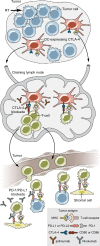Potential role of radiation therapy in augmenting the activity of immunotherapy for gynecologic cancers
- PMID: 29184441
- PMCID: PMC5672877
- DOI: 10.2147/CMAR.S116683
Potential role of radiation therapy in augmenting the activity of immunotherapy for gynecologic cancers
Abstract
Immune checkpoint inhibitors have become an area of intense interest in oncology and are actively being studied in a variety of cancer types with a wide range of success. In vitro data suggest mechanisms by which radiation can activate the immune system, and ongoing studies are exploring the potential interaction of checkpoint inhibitors with radiotherapy in both preclinical and clinical settings. Gynecologic malignancies are a heterogeneous group of tumors with varying prognoses, intrinsic immunogenicity, and potential for response to immune-based therapies. In this review, we focus on the rationale for immunotherapy and opportunities for augmentation by photon radiotherapy in cancers of the cervix, endometrium, and ovary.
Keywords: PD-1; gynecologic; immunotherapy; radiation.
Conflict of interest statement
Disclosure The authors report no conflicts of interest in this work.
Figures


References
-
- Eggermont AM, Chiarion-Sileni V, Grob JJ, et al. Adjuvant ipilimumab versus placebo after complete resection of high-risk stage III melanoma (EORTC 18071): a randomised, double-blind, phase 3 trial. Lancet Oncol. 2015;16(5):522–530. - PubMed
-
- Robert C, Long GV, Brady B, et al. Nivolumab in previously untreated melanoma without BRAF mutation. N Engl J Med. 2015;372(4):320–330. - PubMed
-
- Robert C, Schachter J, Long GV, et al. KEYNOTE-006 investigators Pembrolizumab versus ipilimumab in advanced melanoma. N Engl J Med. 2015;372(26):2521–2532. - PubMed
Publication types
LinkOut - more resources
Full Text Sources
Other Literature Sources

